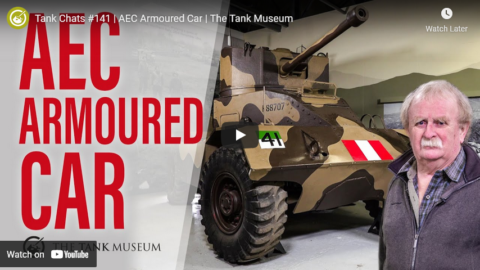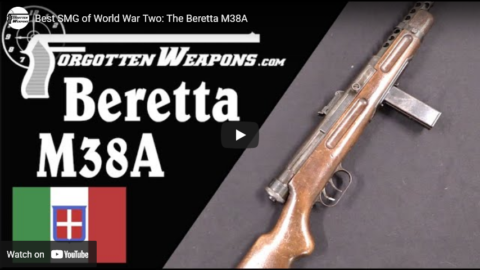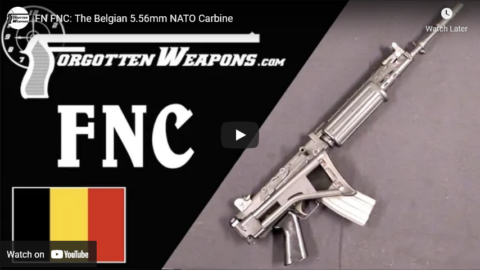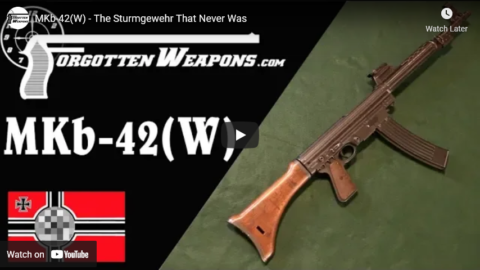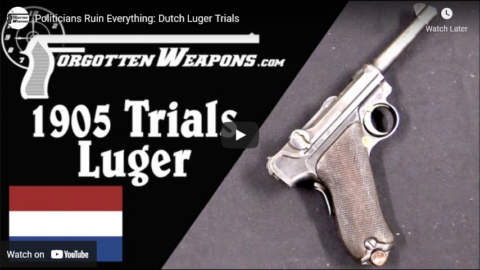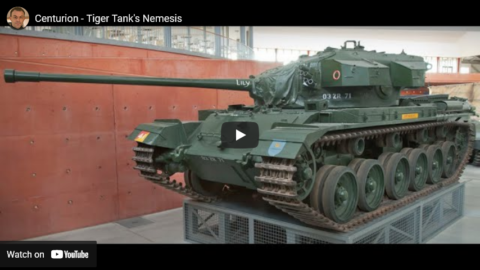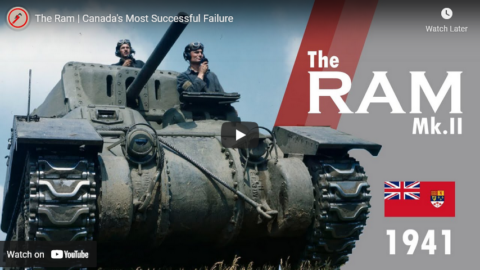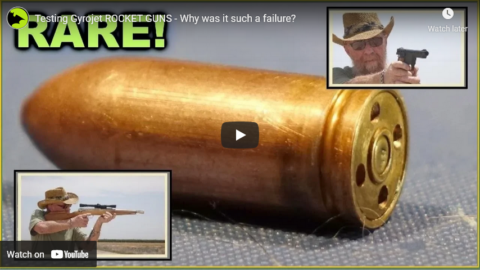The Tank Museum
Published 3 Dec 2021Tune in to our weekly YouTube content today with David Fletcher as he details the AEC Armoured Car!
00:00 – Intro
00:25 – History of the AEC
04:46 – Key FeaturesSupport the work of The Tank Museum on Patreon: ► https://www.patreon.com/tankmuseum
Visit The Tank Museum SHOP & become a Friend: ► tankmuseumshop.orgTwitter: ► https://twitter.com/TankMuseum
Instagram: ► https://www.instagram.com/tankmuseum/
#tankmuseum #tanks
March 22, 2022
Tank Chats #141 | AEC Armoured Car | The Tank Museum
March 18, 2022
Best SMG of World War Two: The Beretta M38A
Forgotten Weapons
Published 15 Nov 2021http://www.patreon.com/ForgottenWeapons
https://www.floatplane.com/channel/Fo…
Cool Forgotten Weapons merch! http://shop.forgottenweapons.com
The Beretta Model 38A was one of the very best submachine guns of World War Two. Designed by veteran Beretta engineer Tullio Marengoni (who designed most of Beretta’s pistols as well as the Beretta M1918 SMG and 1918/30 carbine), it was the first Italian weapon to use a cartridge equivalent to 9x19mm Parabellum instead of 9mm Glisenti. Development began in 1935, and the final version entered production in January 1938.
The change from the Model 38 to 38A is unclear, but seem most likely to be the change from the top ejection of the prototypes to the left-side ejection of the production model. The 38A was formally adopted by the Italian Army in July 1938, but issue was delayed until 1940/41 because Beretta first produced a 20,000-unit order for the Romanian military.
By 1941, the basic design had been significantly simplified, and the Model 38/42 would significantly reduce production cost by removing the magazine well cover, barrel shroud, and removable firing pin. Simplified 38/42, 38/43, and 38/44 models would enter production, but original 38As were also manufactured until 1944 (this particular example is dated 1943). The gun was very popular with both Italian and German troops, and production continued under German occupation late in the war. Total numbers are unavailable, but are probably in excess of 500,000. The gun was so popular that Beretta was able to restart production after the war and continue selling them until the early 1960s.
Contact:
Forgotten Weapons
6281 N. Oracle 36270
Tucson, AZ 85740
March 15, 2022
FN FNC: The Belgian 5.56mm NATO Carbine
Forgotten Weapons
Published 12 Nov 2021http://www.patreon.com/ForgottenWeapons
https://www.floatplane.com/channel/Fo…
Cool Forgotten Weapons merch! http://shop.forgottenweapons.com
The FNC (Fabrique Nationale Carabine) was FN’s followup to the unsuccessful CAL rifle. Chambered for the newly-adopted 5.56mm NATO cartridge, the FNC uses a long stroke gas piston system very reminiscent of the AK, combined with a stamped upper and milled aluminum lower. After about 5 years of development, the FNC was put on the market in 1980, and was quickly purchased by Indonesia, along with a license for domestic production as the Pindad SS-1. It would also be adopted by Sweden as the AK-5 (minus the 3-round burst functionality) and Belgium. About 6,000 semiautomatic sporting models were imported into the US. A number of those, including this one, were legally registered as transferrable machine guns before 1986.
Contact:
Forgotten Weapons
6281 N. Oracle 36270
Tucson, AZ 85740
March 3, 2022
MKb-42(W) – The Sturmgewehr That Never Was
Forgotten Weapons
Published 6 Jul 2018http://www.patreon.com/ForgottenWeapons
Cool Forgotten Weapons merch! http://shop.bbtv.com/collections/forg…
When the German military first requested rifles in the new 8x33mm Kurz cartridge, there were two companies that provided designs. One was Haenel, who would eventually win the competition. The other was Walther, who submitted this rifle — the MKb-42(W). Where the Haenel gun fired from an open bolt and used a tilting-bolt locking system, the Walther rifle fired from a closed bolt and used a rotating bolt to lock. It also used an unusual annular gas piston. In competition, the Walther’s closed bolt operation made it more accurate in semiauto fire and less susceptible to ingress of dirt. However, it was substantially more complex and more expensive than the Haenel gun.
In total, just 200 of the MKb-42(W) were made before being cancelled in late 1942. Needless to say, very few survive today, and it was a great privilege to be able to disassemble and present this one to you. Thanks to the Association of Maltese Arms Collectors and Shooters for the invitation to do so!
If you enjoy Forgotten Weapons, check out its sister channel, InRangeTV! http://www.youtube.com/InRangeTVShow
Contact:
Forgotten Weapons
6281 N Oracle #36270
Tucson, AZ 85704
February 27, 2022
Who is Springfield Armory? A Tale of Two Entities
Forgotten Weapons
Published 20 Feb 2018Today we will take a look at the history of Springfield Armory – both the American national arsenal founded in the 1770s and the commercial entity founded in the 1970s.
http://www.patreon.com/ForgottenWeapons
Cool Forgotten Weapons merch! http://shop.bbtv.com/collections/forg…
If you enjoy Forgotten Weapons, check out its sister channel, InRangeTV! http://www.youtube.com/InRangeTVShow
February 24, 2022
Got Wood? – The de Havilland Mosquito
World War Two
Published 23 Feb 2022What if there was a plane that the enemy could neither catch nor reach? One that fully relied on speed instead of defensive armaments? The de Havilland DH.98 Mosquito was the first multi-role aircraft developed during World War Two. Made mostly out of wood, the “Wooden Wonder” could be easily converted into different roles — a fighter, a fighter-bomber, a bomber, and a reconnaissance aircraft.
(more…)
Politicians Ruin Everything: Dutch Luger Trials
Forgotten Weapons
Published 27 Oct 2021http://www.patreon.com/ForgottenWeapons
https://www.floatplane.com/channel/Fo…
Cool Forgotten Weapons merch! http://shop.forgottenweapons.com
The Dutch military started looking for semiauto pistols to replace its aging revolvers around 1899. They tested all the early models: the Roth, Borchardt, Mauser and Mannlicher — and then they obtained a Borchardt-Luger (aka, a Parabellum, or Luger). They first tested a long-barreled model with shoulder stock for artillery crews in 1901. The guns performed very well mechanically, but the officers in charge were dubious about the utility of the gun.
In 1903, another set of trials was run by the infantry, this time on short-barreled Lugers in both 9mm and 7.65mm. In addition, the Dutch requested a number of special changes to a subset of their guns – this “Dutch Model” was to have Dutch markings and a stronger coil mainspring designed by the Dutch ordnance department. That coil mainspring would be adopted by DWM and became the most significant improvement in the New Model Lugers.
Anyway, the 1903 trials were concluded with much success in 1905, and the Dutch War Minister happily adopted the Luger in 9mm. He wrote out an order to start getting the Army new modern pistols … only to be overridden by the Dutch Parliament. They decided that the new guns were basically too dangerous, and cancelled the adoption. This left the Army in a rather unexpected lurch, and they had to restart production of revolvers in 1906 to make up the shortages in handguns.
Contact:
Forgotten Weapons
6281 N. Oracle 36270
Tucson, AZ 85740
February 18, 2022
Sudayev’s PPS-43: Submachine Gun Simplicity Perfected
Forgotten Weapons
Published 31 Aug 2017The PPS-43, designed by Alexei Sudayev based on a previous submachine gun design by I.K. Bezruchko-Vysotsky, was the Soviet replacement for the PPSh-41. The Shpagin submachine gun was a very effective combat weapon, but was time-consuming to produce and required specialized manufacturing tools. The Soviet military wanted a weapon that was cheaper and faster to make, and which could be produced at small shops not experienced in firearms production. The Sudayev design fit these criteria extremely well, being made almost entirely of simple bent metal components.
Production of the first prototype Sudayev submachine guns begin in 1942 in the besieged city of Leningrad, where guns were quite literally taken from the factory door to the front lines and put into service. A few minor flaws were discovered and corrected, and by the time the siege was broken the gun was suitable for mass production. It was designated the PPS-43, and while it was theoretically a replacement for the PPSh-41, it never did actually replace the former weapon. It was decided to continue PPSh-41 production in the factories already tooled up for it, while making use of the PPS-43’s simplicity to put it into production as a range of new factories that did not have the technical capacity to make more complex weapons.
Mechanically, the PPS-43 was a simple blowback gun, using basically the same conceptual operating system as the PPSH-41. However, Sudayev resolved the most significant practical problem with the PPSH-41 by abandoning its unreliable drums and developing his own new double-stack, double-feed 35-round box magazine. The PPS-43 magazine is simpler to load, more reliable in use, and much smoother to insert and remove from the weapon than PPSh magazines. The improvement was substantial enough to justify the use of different and incompatible magazines in the two guns. In conjunction with the discarding of the drum magazine, Sudayev also designed his gun to have a lower rate of fire than the PPSh, to better manage ammunition supply. However, the roughly 600 rpm rate of the PPS-43 is actually relatively difficult to control in that light weapon, where the PPSh-41 was substantially smoother shooting despite (or perhaps because of) firing faster.
http://www.patreon.com/ForgottenWeapons
Cool Forgotten Weapons merch! http://shop.bbtv.com/collections/forg…
Русская версия: https://youtu.be/TZxgn4iVMbg
February 5, 2022
Centurion – Tiger Tank’s Nemesis
Mark Felton Productions
Published 22 Oct 2020The Centurion, the famous Cold War tank, was actually developed to take on the dreaded German Tiger in WW2. Find out whether they ever met on the battlefield in 1945.
Dr. Mark Felton is a well-known British historian, the author of 22 non-fiction books, including bestsellers Zero Night and Castle of the Eagles, both currently being developed into movies in Hollywood. In addition to writing, Mark also appears regularly in television documentaries around the world, including on The History Channel, Netflix, National Geographic, Quest, American Heroes Channel and RMC Decouverte. His books have formed the background to several TV and radio documentaries. More information about Mark can be found at: https://en.wikipedia.org/wiki/Mark_Fe…
Visit my audio book channel ‘War Stories with Mark Felton’: https://youtu.be/xszsAzbHcPE
Help support my channel:
https://www.paypal.me/markfeltonprodu…
https://www.patreon.com/markfeltonpro…Disclaimer: All opinions and comments expressed in the ‘Comments’ section do not reflect the opinions of Mark Felton Productions. All opinions and comments should contribute to the dialogue. Mark Felton Productions does not condone written attacks, insults, racism, sexism, extremism, violence or otherwise questionable comments or material in the ‘Comments’ section, and reserves the right to delete any comment violating this rule or to block any poster from the channel.
Credits: David Holt; Simon Q.; Tony Hisgett; Danie van der Merwe; Oliver Gottlob.
Thumbnail: The Tank Museum
January 31, 2022
The Ram | Canada’s Most Successful Failure
Red Wrench Films
Published 4 Dec 2020A Canadian Franken-tank that pre-dated the M4 Sherman, the Ram would be an icon of Canada’s industry in the early war years. Ultimately a failure as a battle tank, variants of the vehicle would see combat in Normandy and beyond, as the Kangaroo APC which revolutionised mechanised warfare in 1944 and 1945.
Any feedback is greatly appreciated, I’m always trying to improve.
Any suggestions for the next video? Leave it down in the comments or message me. 🙂
((Like and subscribe))
Please note that the footage I can find on these vehicles is scarce and sometimes the video will not match properly or will perhaps be slightly inaccurate.
Sources:
https://tanks-encyclopedia.com/ww2/ca…
https://www.dday-overlord.com/en/mate…
https://www.friends-amis.org/index.ph…
http://panzerserra.blogspot.com/2015/…Intuit256 by Kevin MacLeod is licensed under a Creative Commons Attribution 4.0 licence. https://creativecommons.org/licenses/…
Source: http://incompetech.com/music/royalty-…
Artist: http://incompetech.com/
January 27, 2022
What Would Ross Do? The .280 Military Match M10 Rifle
Forgotten Weapons
Published 15 Sep 2021http://www.patreon.com/ForgottenWeapons
https://www.floatplane.com/channel/Fo…
Cool Forgotten Weapons merch! http://shop.forgottenweapons.com
There were many different versions of the Ross straight-pull bolt action rifle made and adopted by the Canadian military. However, the version that Sir Charles Ross thought would be best was only ever made as a small run of prototypes. This rifle was called the Military Match M10, in .280 Ross caliber.
The .280 Ross was a powerful cartridge on par with 7mm Remington Magnum, firing a 140 grain bullet at 3000 fps. This made it very flat-shooting, which Ross saw as ideal for minimizing range estimation errors. Ross’ military experience had been in the Boer War, where long range individual marksmanship was perhaps as important as in any other modern military conflict. For his ideal rifle, he used his M1910 action with a Mauser-style 5-round double-column flush magazine, a finely adjustable rear sight with an aperture for precision shooting but also a notch sight for snap shots. He gave a it a 26 inch barrel — longer than many of the rifles being adopted in the early 1900s, but long enough to have good ballistics and a very long sight radius.
Ross presented his rifle to the Canadian and British militaries, but it was not accepted, because of the British retention of the .303 cartridge if for no other reason. Only about two dozen were made, with serial numbers in the 102XX range. Only perhaps half of those still exist today, and it’s a rare treat to be able to examine this one!
Contact:
Forgotten Weapons
6281 N. Oracle 36270
Tucson, AZ 85740
January 12, 2022
QotD: Baumol’s cost disease in architecture and furniture
Remember, the Baumol effect [Wiki] happens when new technology makes some industries more productive. Since the high-tech industries are so lucrative, wages go up. Then low-tech industries have to raise their wages so that their workers don’t all desert them for the high-tech industries. But since low-tech industries aren’t improving their productivity, they just because more expensive, full stop.
If stonemasonry is a low-tech industry, and new high-tech industries are arising all around it, stonemason wages could get prohibitively high (compared to everything else) until nobody wants to hire them anymore. This would create pressure for architectural styles that require as little masonry (or, generalized, human labor) as possible.
This has gotten me thinking about furniture.
I got a new place recently and have been looking for furnishings. Sometimes I look at people’s furniture Pinterests. If Pinterest is any kind of representative window into the soul of the modern furniture-enthusiast, people really like Art Nouveau. […] As far as I can tell, you can’t buy any of these anywhere — they’re a combination of antiques and concept pieces. The people who pin these and pine after these end up getting minimalist Scandinavian furniture with names like UJLIBLÖK, just like everyone else.
Anything that even comes close to the above costs high four to five digits. I don’t know if this is because it’s antique, because it requires more labor, or both.
I’m harping on furniture because it avoids a lot of the complicating factors in architecture. There isn’t some vague collection of “elites” making our furniture decisions. It’s a pretty free market! There are lots of normal middle-class people spending big chunks of money on furniture, lots of them really really like the old stuff, and the old stuff is still either unavailable or unaffordable. It seems like it used to be affordable — it wasn’t just kings and dukes who had the old Art Nouveau stuff — but for some reason that’s changed. I think Baumol effects offer a tidy explanation here, and if we use them to explain furniture, then they start looking really attractive for architecture.
I want this one to be true, because it exonerates our civilization. If we could make things like the Art Nouveau furniture above, or the Taj Mahal, relatively cheaply and easily, then the question of why we aren’t doing that demands an answer. If it’s just a quirk of basic economics, then our civilization is fine, and maybe we can hope that stoneworking technology advances to the point where we can do this kind of thing again cheaply.
Scott Alexander, “Highlights From The Comments On Modern Architecture”, Astral Codex Ten, 2021-10-04.
January 9, 2022
The Korsac EM1 – a British/Polish Bullpup FG-42
Forgotten Weapons
Published 26 Jun 2017Armament Research Services (ARES) is a specialist technical intelligence consultancy, offering expertise and analysis to a range of government and non-government entities in the arms and munitions field. For detailed photos of the guns in this video, don’t miss the ARES companion blog post:
http://armamentresearch.com/british-k…
The Korsac EM-1 (not to be confused with the Thorpe EM-1, which is a completely different rifle) was a bullpup light machine gun based on captured examples of the German FG-42 paratroop rifle. It was developed between 1945 and 1947 by a team led by a Polish refugee designer named Korsac.
It was chambered for the 8mm Mauser cartridge, and used an 18 round magazine adapted from the ZB-26. The operating mechanism was closely copied from the FG-42, as were many elements of the rifle’s controls, including the capability for firing from an open bolt in fully automatic and from a closed bolt in semi-automatic. Unlike the FG-42, it used a short stroke tappet type gas piston, and had a detachable barrel. Ultimately only two examples were built, and only one of those (the one in this video) was completed to firing condition. It suffered from reliability problems in semi-automatic mode, and was quickly sidelined in favor of the other development projects ongoing by 1947. However, many lessons from its development would be put into the EM-2 rifle.
Cool Forgotten Weapons merchandise! http://shop.bbtv.com/collections/forg…
http://www.patreon.com/ForgottenWeapons
If you enjoy Forgotten Weapons, check out its sister channel, InRangeTV! http://www.youtube.com/InRangeTVShow
January 7, 2022
The Most Important Invention of the 20th Century: Transistors
The History Guy: History Deserves to Be Remembered
Published 23 Dec 2019On December 23, 1947, three researchers at Bell labs demonstrated a new device to colleagues. The device, a solid-state replacement for the audion tube, represented the pinnacle of the quest to provide amplification of electronic communication. The History Guy recalls the path that brought us what one engineer describes as “The world’s most important thing.”
This is original content based on research by The History Guy. Images in the Public Domain are carefully selected and provide illustration. As images of actual events are sometimes not available, images of similar objects and events are used for illustration.
All events are portrayed in historical context and for educational purposes. No images or content are primarily intended to shock and disgust. Those who do not learn from history are doomed to repeat it. Non censuram.
Find The History Guy at:
Patreon: https://www.patreon.com/TheHistoryGuy
The History Guy: History Deserves to Be Remembered is the place to find short snippets of forgotten history from five to fifteen minutes long. If you like history too, this is the channel for you.
Awesome The History Guy merchandise is available at:
teespring.com/stores/the-history-guyScript by THG
#ushistory #thehistoryguy #invention
January 3, 2022
Testing Gyrojet ROCKET GUNS – Why were they a commercial failure?
TAOFLEDERMAUS
Published 10 Jun 2018We were able to make the impossible happen: test out two rare Gyrojet rocket guns. Remarkably, instead of just taking one or two shots, we were able to take 4 shots. We were able to learn a lot with these limited test still.
Check out Sean’s Youtube channel:
https://www.youtube.com/c/ReallyGreatGearIf you want to own an amazing book about the MBA Gyrojets:
http://www.gyrojet.net/Special thanks for our Patreon supporters. We could not have done this without you.
https://www.patreon.com/taofledermausMusic:
https://www.youtube.com/watch?v=CRli8…
https://www.youtube.com/watch?v=cKPUn…

